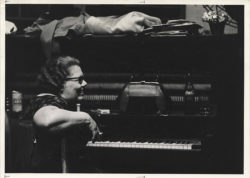Dolly Adams
Jazz pianist Dolly Adams was a respected musician and band leader in New Orleans from the 1920s through the 1970s.

Courtesy of Louisiana State Museum
Dolly Adams. Gulick (Photographer)
Dolly Adams was a New Orleans traditional jazz pianist and multi-instrumentalist. She is considered to be a foundational musician in the history of New Orleans jazz. Although Adams is most recognized for her piano playing, she also excelled at the drums, guitar, and trumpet. From the early to mid-1960s, Adams was a noted performer at New Orleans’s storied Preservation Hall. Though little is known about her, she remains among the most respected women to contribute to the development of jazz.
Adams was born on January 11, 1904, in the Algiers neighborhood of New Orleans to Olivia Manetta and Louis Douroux. Both sides of her family came from prominent musical Creole families of color with Sicilian, French, and African heritage. Her father played cornet and trumpet in a number of local brass bands, including the famed Eureka and Excelsior Brass Bands. Olivia Manetta, sister of the highly sought-after musician and bandleader Manuel Manetta, was herself a skilled trumpet player and multi-instrumentalist.
Adams began playing at age seven, when her family first acquired a piano; however, in a 1962 oral history interview with Bill Russell, she recalls a desire to play from a far earlier age. Dolly continued her musical training at St. Mary’s Academy and under her family’s tutelage. At age nine, she began playing private parties with her brother, a violinist. At thirteen, she joined her uncle Manuel Manetta’s band as a pianist and thus had the opportunity to perform with some of the jazz greats of the era, including Louis Armstrong, Joe “King” Oliver, Kid Ory, and many others. Although gender norms restricted performance opportunities for both Adams and her mother, it is likely that Adams could perform relatively freely outside the home within the protective confines of the family, in the aptly named the Adams Family Band. Performances often took them to brothels and rough venues, including Lulu White’s Mahogany Hall, an infamous place of ill repute in the Storyville district of New Orleans.
In the years that followed, Adams joined Peter Bocage’s band, the Creole Serenaders, and performed for vaudeville acts and in silent movie theaters as a solo artist. Around 1922 she married Placide Adams, a fellow musician. Perhaps, in part, due to pressure from her husband, Adams took nearly the next two decades off from public performance to raise her family. She had seven children, three of whom became notable musicians: Gerald (bass and piano), Justin (guitar), and Placide Jr. (bass and drums).
Her return to public performance gained steam with support from the New Orleans traditional jazz revival of the 1950s and 1960s. In 1962 Adams first performed at Preservation Hall, which was in its second year of operation, again in a family band, this time composed of her musical sons. The family band would play twice at Preservation Hall in the early 1960s. She also performed several times at Preservation Hall with other groups, however, and she was notably present with Punch Miller’s Bunch on January 22, 1965, when jazz elder statesman “Papa” John Joseph famously dropped dead onstage immediately after playing “When the Saints Go Marching In.”
In 1967 Adams suffered a debilitating stroke that largely curtailed her performing career; however, after a year of recuperation, she did continue to perform on occasion. Adams died on November 6, 1979, in New Orleans. Upon her death, the New Orleans jazz magazine Second Line honored her with a cover feature, and the New Orleans Jazz Club presented her family with a certificate commemorating the important role she played in the history of New Orleans jazz.
